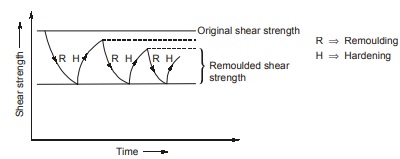Relative Density
- Relative density is also called degree of density or density index.
- It is the index which quantifies the degree of packing between the loosest and densest packing of coarse grained soil.

where,
emax = Void ratio in loosest state
emax = Void ratio in densest state
e = Void ratio in natural state
- It is the most important property of a coarse grained soil.
- Coarse grained soil can be classified on the basis of relative density as given below.
| ID (%) | 0 – 15 | 15 – 35 | 35 – 65 | 65 – 85 | 85 – 100 |
| Classification | Very loose | Loose | Medium | Dense | Very loose |
- High relative density means higher shear strength and low compressibility.
THIXOTROPY
It is that property of soil due to which loss in shear strength due to remoulding at unaltered moisture content may be regained.
Cohesive soils have greater thixotropy than cohesionless soils.
Higher the sensitivity, larger the thixotropic hardening.
- Clays with an initial flocculated structure may loose strength due to disturbance or remoulding. However, with passage of time, the clay may gain the original strength due to thixotropy.
- Thixotropy is defined as an isothermal, reversible, time-dependent process which occurs under constant composition and volume. This phenomenon is attributed to a process of softening caused by remoulding followed by a time-dependent regain of the original hard state.
COLLAPSIBILITY
- Soils which show large decrease in volume with increase in its water content at same pressure are termed as collapsible soil. For example: Loess.
- Collapsibility of the soil is analysed in terms of a parameter termed as collapse potential.
- Collapse potential is defined as the ratio of change in volume of the soil with increase in water content to its original volume.
- Collapse potential can be determined by performing a simple plate load test in the field.
![]()
CP% – Effect on Structure
0 – 1 – No trouble
1 – 5 – Moderate
5 –10 – Trouble
10 – 20 – Severe trouble
> 20 – Very severe trouble
CE Link
CS-IT


